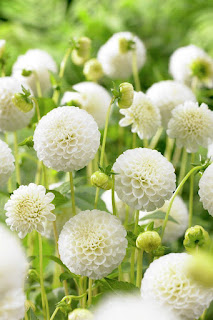The Vibrant World of Dahlias: A Spectrum of Colors and Varieties
Cultivation and Care: Growing Your Own Dahlia Garden
Dahlias are one of the most stunning and diverse groups of flowers in the horticultural world. Native to Mexico and Central America, these vibrant blooms have captivated gardeners and flower enthusiasts worldwide with their remarkable range of colors, shapes, and sizes. With over 42 species and countless cultivars, dahlias offer a rainbow of possibilities for garden design and floral arrangements.
A Kaleidoscope of Colors
The color palette of dahlias is truly extraordinary, encompassing nearly every shade imaginable. Here’s a closer look at some of the standout colors and their variations:
1. Red Dahlias: Red dahlias are the epitome of passion and energy. They range from deep crimson and maroon to bright scarlet and vermilion. Varieties like 'Bishop of Llandaff' showcase a vibrant, deep red, while 'Akita' offers a unique blend of red with white-tipped petals.
2. Pink Dahlias: Pink is a popular color among dahlia enthusiasts for its soft and romantic appeal. Shades range from pastel pink to hot pink. 'Thomas A. Edison' presents a rich magenta hue, whereas 'Otto's Thrill' features large, soft pink blooms that can be the centerpiece of any garden.
3. Yellow Dahlias: Yellow dahlias bring a burst of sunshine to any setting. From pale lemon to golden yellow, these flowers exude warmth and happiness. The 'Kelvin Floodlight' variety is renowned for its giant, luminous yellow blooms.
4. Orange Dahlias: Orange varieties are vibrant and lively, perfect for adding a splash of color. They can range from subtle apricot tones to bold, fiery orange. 'Myrtle's Folly' is a notable cultivar with its fringed petals in shades of orange and pink.
5. White Dahlias: White dahlias symbolize purity and elegance. They can be pure white or have subtle hints of other colors. 'Cafe au Lait' is a popular choice, known for its large, creamy white flowers that often have a hint of blush.
6. Purple Dahlias: Purple dahlias add a touch of mystery and sophistication. They come in shades from light lavender to deep purple. 'Thomas Edison' is a standout with its dark, velvety purple petals.
7. Bicolor and Tricolor Dahlias: These varieties are particularly eye-catching, featuring petals with two or more colors. 'Show 'n' Tell' is a dramatic example, with its red petals tipped in yellow, while 'Rebecca’s World' showcases white petals with bold red streaks.
Varieties and Forms
Dahlias are not only diverse in color but also in their forms and sizes. Here are some of the popular types:
1. Decorative Dahlias: These are among the most common types, characterized by their fully double blooms with broad, flat petals. They come in various sizes and colors, making them versatile for garden displays and cut flowers. Examples include 'Arabian Night' (deep red) and 'Emory Paul' (giant lavender).
2. Cactus Dahlias: Known for their spiky, rolled petals, cactus dahlias have a striking appearance. The petals can be straight or incurved, adding texture and interest. 'Bright Star' and 'Nuit d’Ete' are popular varieties in this category.
3. Pompon and Ball Dahlias: These dahlias have small, perfectly round blooms made up of tightly packed petals. Pompon dahlias are smaller, while ball dahlias are slightly larger. Both types are excellent for creating uniformity in bouquets. 'Small World' (white) and 'Rocco' (purple) are charming examples.
4. Collarette Dahlias: Featuring a unique form, collarette dahlias have a single row of flat petals with a collar of shorter petals around the center, giving them a distinctive look. 'Night Butterfly' (deep red with white collar) is a striking variety in this group.
5. Anemone Dahlias: These have a central cushion of tubular florets surrounded by one or more rings of flat ray petals. The contrasting textures make them highly attractive. 'Blue Bayou' is a notable anemone dahlia with its purple center and pink petals.
6. Single Dahlias: Simple yet elegant, single dahlias have a single row of petals surrounding a central disc. They are reminiscent of daisies and are often favored for their understated beauty. 'Happy Single Flame' with its bright orange petals and dark foliage is a popular choice.
Cultivation and Care
Growing dahlias can be a rewarding experience, provided you follow some basic guidelines:
- Soil and Location: Dahlias prefer well-drained, fertile soil and a sunny location. They thrive in areas that receive at least six hours of sunlight daily.
- Planting: Plant dahlia tubers in the spring after the last frost. Space them about 18 to 24 inches apart and bury them 6 to 8 inches deep.
- Watering: While dahlias need regular watering, especially during dry periods, it's essential to avoid waterlogging, which can cause the tubers to rot. In a week once or twice Water deeply.
- Fertilizing: Feed dahlias with a balanced, low-nitrogen fertilizer. Too much nitrogen promotes foliage at the expense of blooms.
- Staking: Tall dahlia varieties benefit from staking to support their heavy blooms. On the planting time Insert stakes to avoid damaging the tubers later.
- Pest and Disease Control: Keep an eye out for common pests like aphids, slugs, and spider mites. Regularly inspect the plants and treat infestations promptly with appropriate methods.
- Deadheading and Pruning: Remove spent blooms to encourage continuous flowering. Prune the plants to maintain shape and remove any weak or overcrowded stems.
Conclusion
The world of dahlias is a vibrant tapestry of colors and forms, offering something for every garden and floral arrangement. Whether you're drawn to the fiery reds and oranges, the soothing pinks and whites, or the dramatic purples and bicolors, there is a dahlia to suit every taste. By understanding the different varieties and providing proper care, you can enjoy the stunning beauty of these flowers from late summer until the first frost. Dahlias truly embody the diversity and richness of nature’s palette, making them a beloved choice for gardeners and flower enthusiasts alike.









Comments
Post a Comment
If you have any doubt, please let me know, thanks for your love and response